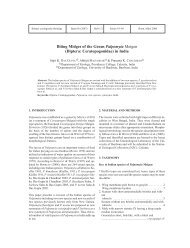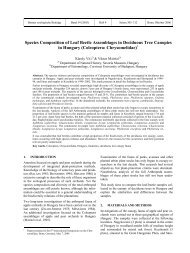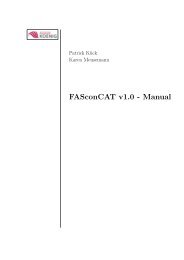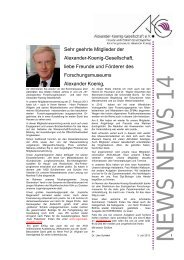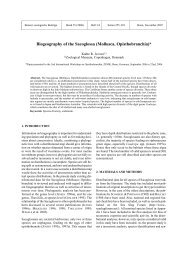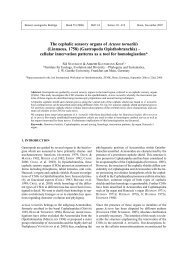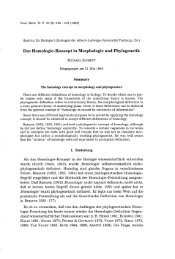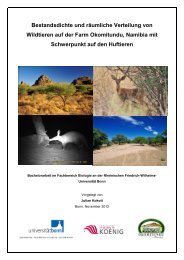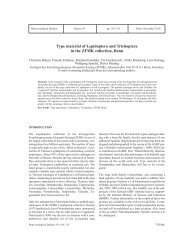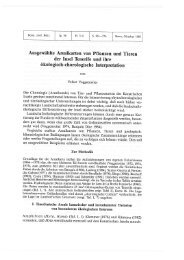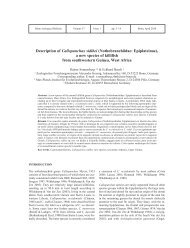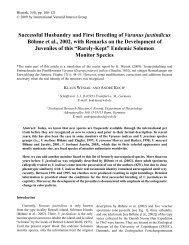Islands Between the Realms: A Revised Checklist of the ...
Islands Between the Realms: A Revised Checklist of the ...
Islands Between the Realms: A Revised Checklist of the ...
You also want an ePaper? Increase the reach of your titles
YUMPU automatically turns print PDFs into web optimized ePapers that Google loves.
Bonner zoologische Beiträge 56 (2007)<br />
111<br />
The website http://collections.oeb.harvard.edu/Herp/Rept-<br />
Search.htm provides information on Talaud specimens in<br />
<strong>the</strong> MCZ collections.<br />
3. RESULTS<br />
ANNOTATED CHECKLIST OF THE AMPHIBIANS AND REP-<br />
TILES OF THE TALAUD ISLANDS<br />
AMPHIBIA<br />
Hylidae<br />
Litoria infrafrenata (Gün<strong>the</strong>r, 1867) (Fig. 5)<br />
Material examined: MZB Amph. 11480, 11490, 11492<br />
(AK039-040, AK072)<br />
Additional material: MCZ A-24288, Karakelong, coll.<br />
FAIRCHILD Garden Expedition 1940; ZMA 8570 (3 spec.),<br />
Lirung, Salibabu, coll. M. WEBER 1899; ZMA 8576 (1<br />
spec.), Beo, Karakelong, coll. M. WEBER 1899.<br />
Morphology: VAN KAMPEN (1907) mentioned that disk<br />
size varies in this species. Thus, in specimens from Lirung<br />
for instance, <strong>the</strong> disks are smaller than <strong>the</strong> tympanum (in<br />
one specimen three vs. four mm). The same relation applies<br />
to our voucher specimens where <strong>the</strong> disks are also<br />
smaller than <strong>the</strong> eye diameter. SVL <strong>of</strong> largest specimen<br />
(MZB Amph. 11492) 115.5 mm; TiL: 62 mm. Males exhibit<br />
black rugosities on <strong>the</strong> inner side <strong>of</strong> <strong>the</strong> first finger.<br />
This is <strong>the</strong> case in our specimen MZB Amph. 11480.<br />
Microhylidae<br />
Callulops cf. dubius (Fig. 6)<br />
Material examined: MZB Amph. 11443 (AK047), MZB<br />
Amph. 11469 (AK054), MZB Amph. 11470 (AK053),<br />
MZB Amph. 11496 (AK074), MZB Amph. 11500<br />
(AK052).<br />
Distribution: Our findings on Salibabu Island expand <strong>the</strong><br />
known range <strong>of</strong> <strong>the</strong> genus by approximately two hundred<br />
kilometers to <strong>the</strong> north and represent a new family record<br />
for <strong>the</strong> Talaud <strong>Islands</strong>.<br />
Ecology: Subadult and adult voucher specimens were ei<strong>the</strong>r<br />
found in small holes near <strong>the</strong> base <strong>of</strong> trees (Fig. 6),<br />
or after rainfall near a small stream in <strong>the</strong> early evening<br />
hours (7.30–8.30 pm).<br />
Morphology & Taxonomy: Characteristically shortsnouted,<br />
small frogs with short limbs: SVL 23.0–39.6 mm,<br />
TiL 9.5–15.5 mm; dorsally uniform dark brown to gray-<br />
Fig. 5. Litoria infrafrenata from Salibabu Island. Photo by André<br />
Koch.<br />
Distribution: VAN KAMPEN (1907) was <strong>the</strong> first to record<br />
this species for <strong>the</strong> Talaud <strong>Islands</strong> (at that time as Hyla<br />
dolichopsis Cope, 1867, a junior synonym <strong>of</strong> L. infrafrenata).<br />
According to BARBOUR (1912) it “(…) is <strong>the</strong> most<br />
widespread Hyla <strong>of</strong> this whole region [i.e. <strong>the</strong> Indo-Australian<br />
Archipelago]”. He listed four female specimens<br />
from Lirung and Beo, on Salibabu and Karakelong, respectively.<br />
Later however, VAN KAMPEN (1923) only states<br />
“Talaut <strong>Islands</strong>” without specifying <strong>the</strong> exact locality.<br />
Fig. 6. Callulops cf. dubius from Salibabu Island. Photo by André<br />
Koch.




